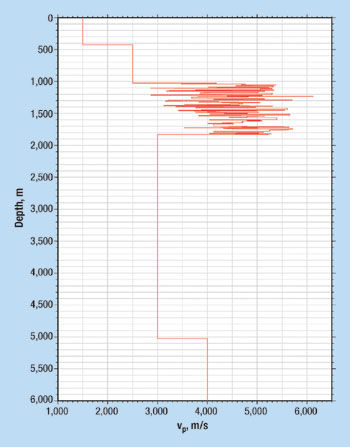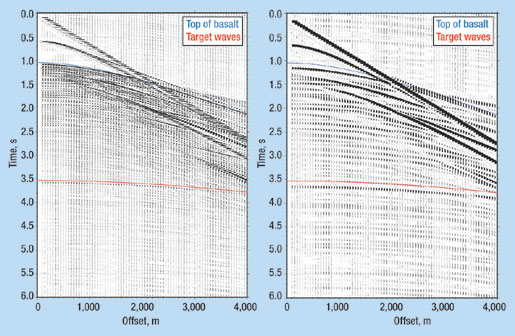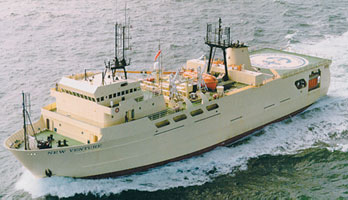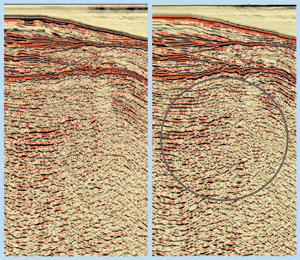New seismic source helps in sub-basalt imaging
GEOLOGICAL AND GEOPHYSICAL APPLICATIONSNew seismic source helps in sub-basalt imagingNew activity offshore the Faroes has added impetus to solving the problem of getting good seismic images beneath high-velocity strata. A solution has emerged that shows promiseHelmut Jakubowicz, Veritas DGC Professor Anton Ziolkowski of Edinburgh University in Scotland has recently suggested that, since sound waves travel more easily through thin layers at low frequencies than high frequencies, low-frequency surveys could provide better seismic images in some geological settings. For example, many prospective areas in the Atlantic Margin northwest of the UK are overlain by Cenozoic flood basalts, and these act as sound barriers that prevent clear seismic imaging in deeper formations. However, results from recent field experiments in this area support Professor Ziolkowski’s idea, and show that there is potential for obtaining seismic information on the deep geology by increasing the low frequency energy recorded during data acquisition.1 Establishing The Concept Modeling studies of wave propagation in inhomogeneous media show that heterogeneity can be described using equivalent homogeneous anisotropic media, provided that seismic wavelengths are about an order of magnitude longer than the scale of the variations.2,3 Field studies of basalts in the NE Atlantic Margin indicate that most are very heterogeneous, and these variable features often have lengths an order of magnitude less than seismic wavelengths for frequencies of 10 Hz or less.4 Thus, seismic waves at these frequencies should avoid the thin layering and heterogeneity problems, and could provide enough seismic energy to penetrate the basalt and allow reflection imaging of the deeper structure. To confirm this conclusion, synthetic seismic data were generated for a model incorporating measured basalt velocities from a well, together with a deeper, idealized target reflector with a two-way traveltime of around 3.5 s, Fig. 1. The resulting offset dependent synthetic seismograms show that, with a central frequency of 35 Hz (Fig. 2, left), the response of the target reflector is very weak. However, when the central frequency of the data is reduced to 10 Hz (Fig. 2, right), the reflection from the sub-basalt interface is much more apparent. This result supports the idea that low frequencies could help provide information in areas where this type of basalt is present.
Executing The Idea Unfortunately, it is far from easy to obtain ultra-low frequency seismic data – especially in the marine environment. The air guns used in marine seismic surveys can be tuned to different frequencies, in this case by varying the amount of air they release and changing the depth at which they are deployed in the water. However, to generate frequencies that are low enough to be able to penetrate basalt, the airguns have to be both deeper in the water and four to five times the normal size used for exploration. As a result, the equipment required for this type of survey is far from standard, and, from a practical point of view, much more difficult to handle. Notwithstanding the problems inherent in configuring the airguns, Veritas DGC decided that Professor Ziolkowski’s idea was sufficiently interesting to warrant a full-scale test. Consequently, the company’s Marine Acquisition Groups in Crawley, UK, and Houston, Texas, were challenged with the task of creating equipment that would be suitable for generating the very low frequencies. They were eventually successful, and deployed the new source on the company’s seismic vessel, M/V New Venture.
Blast The first experimental survey in the Alantic Margin to use the new source was named BLAST (Basalt Large Airgun Seismic Test). The test itself was performed in the summer of 2001, and was specifically designed to investigate whether the new source would pìovide additional geological information below the basalt layers in the Faroes licensing areas. It was jointly funded by Veritas and the members of Faroes License Group 6 (Statoil, Anadarko, Enterprise, Phillips Petroleum and Veba Oil). Since then, the new array has also been used on a proprietary program targeting sub-basalt structures in UK waters on behalf of Texaco Britain Ltd. In addition to the novel source, both the BLAST and Texaco surveys used new, state-of-the art solid streamers. These new streamers have improved signal-to-noise characteristics compared to conventional fluid-filled cables, and are therefore better able to sense weak reflections from beneath the basalt formations. In addition, both surveys employed 12-km streamers, thereby offering access to wide-angle information, as well as additional opportunities for enhancing the data in processing. The combination of low-frequency source and ultra-long sensitive streamers proved ideal for testing Professor Ziolkowski’s idea. Detailed analysis of both the BLAST and Texaco datasets is still in progress. However, the initial results are encouraging, and comparisons with data obtained from older surveys show strong evidence that the new source configuration can produce reflections beneath the basalt that are not obtained in conventional surveys, Fig. 4.
Conclusion The BLAST results are very promising and represent a significant advance in data acquisition for basalt-covered areas, such as those found in the Atlantic Margin. However, this approach may also be useful in other parts of the world, including regions with quite different geological settings. There is a good chance that the industry will see increasing interest in seismic acquisition with very low-frequency sources of this type. Meanwhile, Professor Ziolkowski is continuing to work on exploiting low-frequency information, and is developing his ideas in a joint research project with the British Geological Survey, Texaco Britain and Veritas. In addition, Veritas is trying to make an even better low-frequency source, which, if everything proceeds according to plan, will be available for further surveys by mid-2002. Literature Cited 1 Ziolkowski A., P. Hanssen, R. Gatliff, X. Y. Li, and H. Jakubowicz, "The use of low frequencies for sub-basalt imaging," SEG 71st Annual Mtg. Abstracts, San Antonio, Texas, Sept. 9 – 14, 2001. 2 Ebrom, D., Tatham, R., Sekharan, K. K., McDonald, J. and Gardner, G. H. F., "Dispersion and anisotropy in laminated versus fractured media: An experimental comparison," SEG 60th Annual Mtg. Abstracts, pp.1416 – 1419, 1990. 3 Liu, E., J. A Hudson and T. Pointer, "Equivalent medium representation of fractured rocks," Journal of Geophysical Research, Vol. 105, pp. 2981 – 3000, 2000. 4 Gatliff, R. W., K. Hitchen, J. D. Ritchie and D. K. Smythe, "Internal structure of the Erlend Tertiary volcanic complex, north of Shetland, revealed by seismic reflection," Journal of the Geological Society, Vol. 141, pp. 555 – 562, 1984.
|
|||||||||||||||||||
- Quantum computing and subsurface prediction (January 2024)
- Mixed outlook for activity on the UK Continental Shelf (December 2023)
- Machine learning-assisted induced seismicity characterization of the Ellenburger formation, Midland basin (August 2023)
- What's new in exploration (March 2023)
- Seismic and its contribution to the energy transition (January 2023)
- First Oil: Sorting through the muddled mess (November 2022)
- Applying ultra-deep LWD resistivity technology successfully in a SAGD operation (May 2019)
- Adoption of wireless intelligent completions advances (May 2019)
- Majors double down as takeaway crunch eases (April 2019)
- What’s new in well logging and formation evaluation (April 2019)
- Qualification of a 20,000-psi subsea BOP: A collaborative approach (February 2019)
- ConocoPhillips’ Greg Leveille sees rapid trajectory of technical advancement continuing (February 2019)






